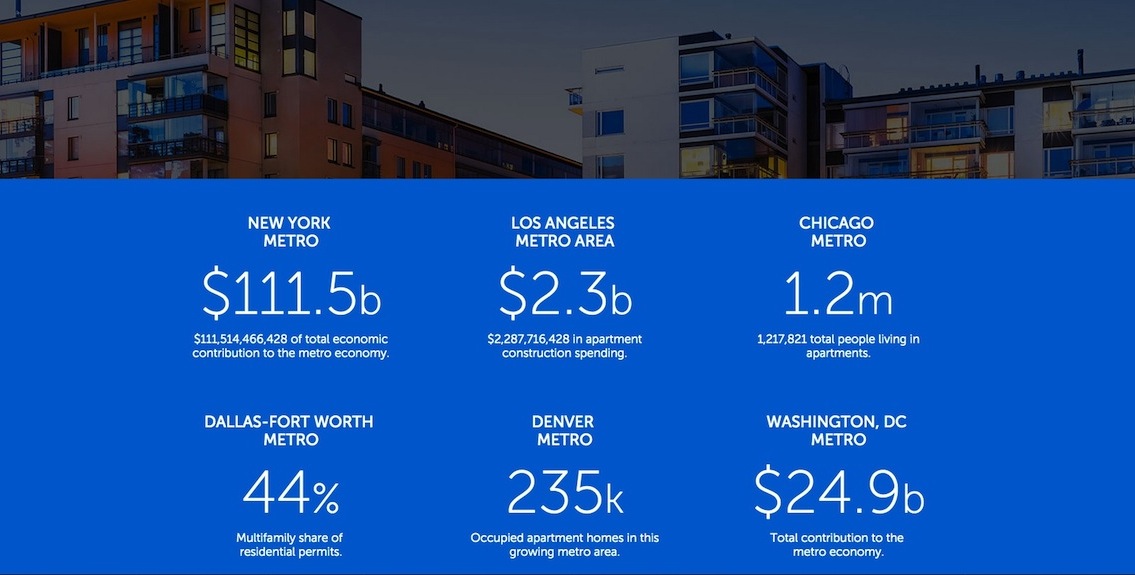The National Multifamily Housing Council and the National Apartment Association launched the latest phase of “WeAreApartments,” a marketing campaign that promotes the importance of the apartment industry to the U.S. economy.
Using research from George Mason University’s Center for Regional Analysis, the groups claim that there are more than 37 million Americans—12% of the population—living in just under 20 million apartment units nationwide. Apartments and their residents contribute $1.3 trillion annually to the economy through construction, property management, and other jobs the industry supports.
This research provides some interesting factoids about the apartment sector: For example, 49% are one-person households, compared to 24% of apartments with three or more people in them. The highest portion of apartment buildings—27%—has either 50 units or more, or a between five and nine units. The apartment housing stock is aging, too: more than half was built between 1959 and 1979.
The campaign contends that the country needs between 300,000 and 400,000 new apartments each year to keep up with demand.
Apartments contribute more to the New York metropolitan area’s economy—$111.5 billion annually—than in any other market. Multifamily accounted for 44% of residential permits issued in Dallas-Fort Worth last year. And $2.3 billion was spent on apartment construction in Los Angeles.
(The campaign’s website includes an Apartment Community Estimator, which allows metros and states to figure out the economic construction from the apartment sector in their respective areas.)
The campaign contends that the country needs between 300,000 and 400,000 new apartments each year to keep up with demand. “What construction has accelerated in response, many communities still lack sufficient housing options,” it reports.
To get its message out, the groups sponsoring this campaign have devised a new series of print and online ads that attempts to get beyond perceived stereotypes about apartment dwellers. For example, one ad shows a young African-American woman sitting in the kitchen of her apartment. The ad describes her as “Botanist. Swim Coach. Pickle Easter. Renter,” followed by the campaign’s tagline “Apartments. We Live Her.” Another ad states humorously that “Liberals Live In Them. So Do Conservatives, But In Another Wing.”
One of the campaign’s more provocative messages is that apartment dwellers are fulfilling their “The American Dream.” That phrase, heretofore, had been reserved for homeownership, but younger Americans’ avidity for owning a house is still uncertain.
Related Stories
Contractors | Jan 7, 2021
The Weekly show, Jan 7, 2021: Preconstruction boot camp, and leadership strategies for navigating a challenging market
The January 7 episode of BD+C's The Weekly is available for viewing on demand.
Architects | Jan 5, 2021
Ware Malcomb finds itself in the mix for multiple diverse projects
Its latest completion is an office/factory/warehouse combo for one of Marvin Window’s brands.
Architects | Jan 4, 2021
Moody Nolan receives 2021 AIA Architecture Firm Award
Founded by Curt Moody, FAIA, NOMA, and the late engineer Howard E. Nolan, the firm’s work is centered on the belief that diverse perspectives foster creativity and more responsive solutions.
AEC Tech | Dec 17, 2020
The Weekly show: The future of eSports facilities, meet the National Institute for AI in Construction
The December 17 episode of BD+C's The Weekly is available for viewing on demand.
Multifamily Housing | Dec 16, 2020
What the Biden Administration means for multifamily construction
What can the multifamily real estate sector expect from Biden and Company? At the risk of having egg, if not a whole omelet, on my face, let me take a shot.
Giants 400 | Dec 16, 2020
Download a PDF of all 2020 Giants 400 Rankings
This 70-page PDF features AEC firm rankings across 51 building sectors, disciplines, and specialty services.
Architects | Dec 14, 2020
2021 AIA Gold Medal awarded to Edward Mazria
The Gold Medal honors an individual whose significant body of work has had a lasting influence on the theory and practice of architecture.
Healthcare Facilities | Dec 10, 2020
The Weekly show: The future of medical office buildings, and virtual internship programs
This week on The Weekly show, BD+C editors spoke with leaders from SMRT Architects and Engineers and Stantec about the future of medical office buildings, and virtual internship programs
Multifamily Housing | Dec 4, 2020
The Weekly show: Designing multifamily housing for COVID-19, and trends in historic preservation and adaptive reuse
This week on The Weekly show, BD+C editors spoke with leaders from Page & Turnbull and Grimm + Parker Architects about designing multifamily housing for COVID-19, and trends in historic preservation and adaptive reuse
Giants 400 | Dec 3, 2020
2020 Science & Technology Facilities Giants: Top architecture, engineering, and construction firms in the S+T sector
HDR, Jacobs, and Turner head BD+C's rankings of the nation's largest science and technology (S+T) facilities sector architecture, engineering, and construction firms, as reported in the 2020 Giants 400 Report.

















